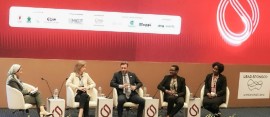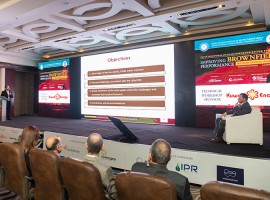By Hugh Fraser, Office Managing Partner, Andrews Kurth Middle East
The Challenges
2017 promises to be a year of transformation for the Egypt energy sector. The Minister of Petroleum, Tarek El Molla, speaking at the OTC Conference in Houston in May last year candidly pointed to the challenges the Egyptian Government was facing with IOC debt accumulations, the burden of fuel subsidies and the impact of currency and expatriation of funds concerns among foreign investors. However, only seven months’ later the Minister led a strategic forum on the roadmap for establishing Egypt as a regional energy hub. It will be interesting to chart Egypt’s progress over the full 12 months’ period when OTC 2017 comes around.
The announcement in November that the IMF had given its final approval for a $12 billion funding package for Egypt, while welcome news, brought with it the requirement to float the Egyptian Pound resulting in an exchange rate which started 2016 at EGP 7.815 to the US Dollar and ended it at EGP 18 after almost touching EGP 20. While this brings huge challenges for businesses locked into funding US Dollar commitments the other side of the balance sheet will show that the commercial attractiveness of Egyptian goods, labor and assets for foreign investors has reached a new dimension. The challenges of the IOC debts and fuel subsidies remain and Shell’s recent announcement that it has ceased further investment in its Rosetta development and has put the asset up for sale was a timely reminder that the unpaid IOC debts remain a brake on necessary investment.
Positive Progress and Results
However, significant progress has been made in three distinctive areas. First, the deepwater gas projects at Eni’s Zohr field and BP’s West Nile Delta Phase 1 development remain on track to produce first gas in 2017. With $24 billion being invested across both developments, Egypt has brought in major contracts for the likes of Subsea 7, OneSubsea, and Aker Solutions at a time when other markets have been severely depressed. Second, the recent awards of onshore acreage to Apache, BP, Shell, and Apex with apparent government concessions on the cost recovery mechanisms and relinquishment rules, demonstrated that the country’s onshore oil production prospects remain positive. Thirdly, thanks largely to the impact of Siemens-led power production projects, Egypt now has moved into a healthy position of surplus power capacity.
The Deepwater Gas Bonanza
If BP’s actions are to serve a barometer in confidence in Egypt’s energy future, its acquisition of a 10% share in the Shorouk development, which includes the Zohr field and increase of its interest up to 82.75% in the WND project by acquisitions from RWE bode well, as does Rosneft’s acquisition of 30% of Shorouk for $1.1 billion. The exploration prospects for the East Mediterranean continue to excite the international petroleum community and who would bet against Edison, who shared the stage with Eni and BP at the MOC Conference in Alexandria in April, being the next to announce major good news, given it holds the block positioned between the Zohr field and the massive Leviathan fields across the maritime border with Israel.
The Power Generation Mix
While the progress that Siemens has made in the country has been welcome, the downside may well be that the foot “comes off the gas” on other power development projects with larger question marks resting over the timing of the various nuclear, coal and renewables projects, which have been on the drawing board since the 2015 Sharm El Sheikh international investment summit as 2017 commences. The reduced pressure on Egypt’s supply and demand dynamics was further demonstrated by the cancellation of the tender for the country’s proposed third floating storage and regasification unit (FSRU) as the year came to a close.
Towards a Regional Energy Hub
However, this coincided with a strategic forum led by the Petroleum Minister, which set down the roadmap for Egypt establishing itself as a regional energy hub. This is a logic to this case given Egypt’s refining and LNG facilities, the proposed Tahrir petrochemicals complex, the exploration and production activities in the East Mediterranean and the presence to the north of the world’s third largest energy consumer, the European Union.
Gas and Electricity Liberalization
On the regulatory front, the Government appears to remain committed to its liberalization plans for the gas and electricity markets. These strategic objectives will offer some of the best opportunities for entrepreneurial Egyptian business to push into the market with the right financial investors and technology partners. These topics will be the subject of two strategic round tables hosted by Egypt Oil and Gas towards the end of the first quarter of 2017, which will examine the details of the recent and proposed Electricity and Gas Laws and the roadmaps for their roll out and implementation. However, these are complex and ambitious programs and the question remains whether there will be major “breakthrough” developments in 2017.
Privatization and the Development Banks
The final key dimension, which must be mentioned, is the Government’s pending privatization program with IPOs being referenced for the likes of ENPPI and MIDOR with the objective of raising $10 billion of investment within the next three to five years. The privatization theme is shared regionally in Saudi Arabia and Kuwait, who are embarking on major program. This perhaps highlights the key challenge for Egypt in 2017. If the pending gas bonanza delivers genuine game changing positives for the Egyptian economy by 2020 and the energy hub strategic objective can be achieved within the same time frame, the 2015 conference may yet emerge as the trigger point, which set Egypt on the road to a better future. The key remains as to how projects can be financed and general liquidity in the energy sector improved during the next three years. Privatization might not offer a fast enough and big enough solution and so the focus in the short term must remain on the IMF funding and on the role of the development banks. The European Bank for Reconstruction and Development (EBRD) recently announcement a $140 million funding program, in association with QNB AlAhli Bank of Egypt, focused on SMEs and energy efficiency projects in Egypt. This is a welcome initiative.
In summary, can we look forward to a year of transformation in Egypt in 2017? In the short term it does appear that the “financing” issue will dominate the start of the year, but hopefully the start of revenues from the East Med gas bonanza will be the dominant topic by the year end. The first reference point will be DMG’s Egypt Petroleum Show in Cairo on 14-16 February. It would be fitting for Egypt’s energy hub ambitions if this event can emerge over the next five years as the “ADIPEC of North Africa,” but in the short term it will be our first major opportunity to check in on how 2017 is progressing.








